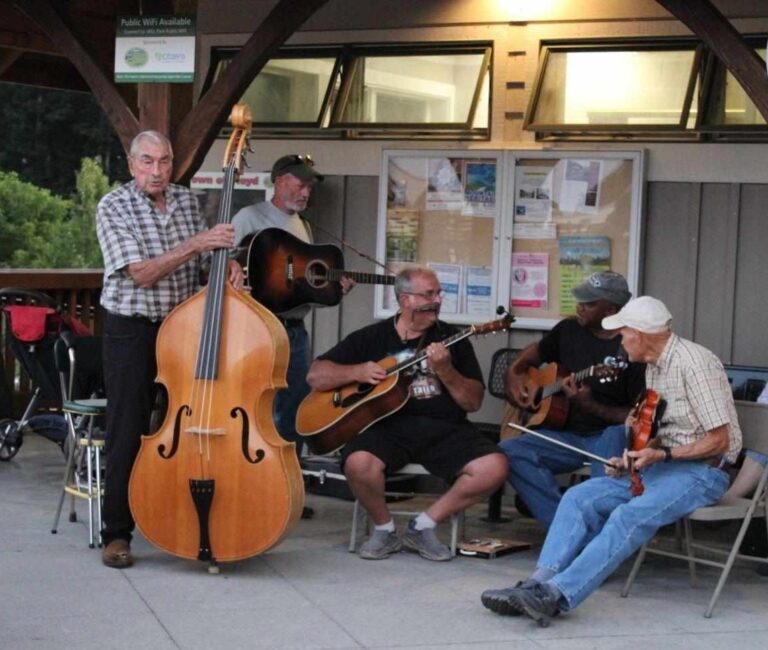While its parallel-running Shenandoah Valley counterpart, U.S. 11, gets a lot of attention, the draw of U.S. 340 is its scenic isolation. With the peaks of the Shenandoah National Park looming directly to the east, the route winds northward from Waynesboro to Front Royal, passing through some of the most beatific landscapes the state has to offer.
Hugging the banks of the South River, 340 starts off hop-scotching through the tiny, former-railroad hamlets of Crimora, Harriston and Grottoes to Port Republic, where the South, Middle and North Rivers converge to form the Shenandoah River’s South Fork. Turn into any of these communities and you’ll discover clusters of beautifully restored river-fronting homes (many of them adorned with plaques offering delicious historical morsels regarding heritage and prior glories), as well as the dilapidated remains of 40s and 50s-era service stations, general stores, taverns and warehouses. The latter, unfortunately, feature no such markers.
“From the 1860s into the late 1950s, this was home to the country’s biggest manganese mine,” a dark-skinned octogenarian named Lucius Simpkins tells me from his seat outside a Crimora gas station. A crucial ingredient in the steel-making process, extraction had peaked during World War I. “There was a railroad station in the village and, in my father’s time, people came from all around to work the mines. In them days, this was a pretty busy place.”
Just inside of Grottoes, intrigued by a National Park Service sign advertising “America’s Oldest Show Cave,” my fiancé urges me to hang a left on VA 256 and follow the arrows to Grand Caverns Park. Situated just beyond a small bridge over the South River, the park is nestled into a high hillside and features an old-fashioned visitor’s center, pavilions, tree-lined fields, a pool and a few miles of hiking and biking trails. At the end of an asphalt path leading up a long hill is a small red clapboard museum, which houses the entrance to the caverns. Inside, we encounter an array of cave artifacts, both natural and historical. There are vertically sliced geodes, stalagmites and other subterranean formations; a cache of 19th-century mason jars, Civil War medals and bullets; and, my personal favorite, a stuffed albino fox.
“An 18-year-old trapper named Bernard Weyer stumbled onto the cave’s opening in 1804 while looking for a lost trap,” says Grottoes tourism and parks director, Nathan Garrison. “Back then, the entrance was no more than a hole in the hillside the size of your waist.”
Whether curious or insane, Weyer shimmied into the dark opening, and, to his amazement, proceeded to discover Grand Caverns (which the NPS subsequently declared a National Natural Landmark in 1973).“He kind of became obsessed,” says Garrison. “He wound up spending the next two years exploring what proved to be a 3.78-mile system, and, by 1806, had enlarged the opening and started offering public tours. Which made this the first ‘show cave’ in America.”

Entering via a wood-paneled corridor reminiscent of a mine shaft, we’re hit by a wash of cool, musty underground air. Descending along the 200-year-old footpath, we pass through thin rocky passages into long, cathedral-sized rooms with 70-foot ceilings illumined by spotlights. Overhead, whitely gleaming columns and shield-shaped petals of stone hang like giant frozen pillars of melted wax. “These were formed by more than 100,000 years of water dripping through limestone,” explains our guide. At that point, the first homo sapiens were still 40,000 years away from wandering out of Africa.
Later we’re told a story about how, in the comparatively recent late-19th century, dances were held in the caverns. Lit by oil-burning lanterns, local string bands would setup in an arched stone recession in a big oval-shaped room about a quarter-mile from the entrance. “The cave was a natural echo-chamber, so the sound was much bigger and louder than what you’d hear elsewhere,” says the guide. “Believe it or not, the events became quite the attraction.”
Enchanted by the warm yellow-orange flames dancing shadows across the walls and the amplified wail of fiddles, banjos, guitars and vocalists, the couples would step, spin and sway until deep into the night.
Thirty-one miles into the journey, we pass through the town of Elkton—home of what is believed to be the state’s oldest and largest bur oak tree—and spot the 2,923-foot peak of Massanutten Mountain to the west. For the next 50 miles, the range will continue, and the road will effectively be bowled in by mountains.
Climbing through long stretches of farmland bursting with forests and bisected by a thousand creeks and streams, eventually, we cross the South Fork and enter Luray. Here, the road merges with U.S. 211, and for the next 5 miles things get comparatively congested. Despite the billboards beckoning us to indulge the Luray Zoo, Caverns, Car & Carriage Caravan Museum, or Toy Town Junction, the corridor of strip malls is an unwanted reminder of the hustle-bustle world we’ve left behind.
Luckily, the segment is redeemed by Triple Crown Barbecue. Just off the highway, the eatery sits in the parking lot of owner John Coleman’s furniture-making workshop and consists of an enclosed pull-behind trailer surrounded by a permanent deck. While appearing somewhat dive-like, since Coleman and his wife, Joanne, opened TCB in 2011, the stand has developed an almost religious following.



“I don’t like to toot my own horn, but I think of myself as a barbecue connoisseur,” drawls Ray Johnson, a 50-year-old tractor salesman from Willow Spring, N.C, who says he’s in the area on business. “And this here’s the best I’ve ever had, bar none. I go out my way to stop by whenever I’m in town, and I always—and I do mean always—bring home a little extra for the wife,” he adds with a wink and a big Southern belly laugh.
Unsure of what to try, we order the Smoked Sampler—a quarter chicken, quarter pound of pulled pork, quarter rack of ribs, and quarter pound of sliced beef. Sitting at a nearby picnic table, we dig in and, holy OMFG, are by no means disappointed. Tender, juicy, bursting with flavor, taking a bite is like getting hit by a freight-train of smoky decadence.
What is it that makes the Coleman’s meats so special?
“My granddaddy was the pit master for his local Lions Club for 40 years,” confides Joanne. “He grew up in the country. His family were homesteaders, and he learned from them. When John and I got married, we started having big family events, and he’d come cook for us. He taught us everything we know.”
After pausing in Bentonville for a 7.8-mile afternoon jaunt through the Shenandoah River State Park to view-ample Culler’s Overlook, we pass through the charming little town of Front Royal just in time to make our 7 p.m. dinner reservations at L’Auberge Provencale Bed and Breakfast’s in-house restaurant, La Table.
The crowning culinary jewel of both 340 and the greater Shenandoah Valley, La Table is housed within a renovated stone manor dating to the dominion of Lord Fairfax, in 1753. Featuring the abounding warmth of a traditional French countryside inn—there are antique furnishings throughout and wall ornaments like heirloom 19th-century copper cookware from Avignon, France—L’Auberge is a laidback food-lover’s wonderland.
“We have a AAA four-diamond rating and were founded in 1981 by fourth-generation French chef, Alain Borel, whom, among a very long list of accolades, was named a Great Country Inn Chef by the James Beard Foundation in the early 90s,” says concierge Christian Bentley, showing us through a chic, g`ranite-rich bar and bistro to the octagonal, window-lined dining room.
Taking a seat at a table draped with a classic white cloth, we’re greeted by a Chef’s Tasting Menu. The seven-course meal with wine pairings—$135 and $89 per person, respectively—is sculpted from some of the freshest seasonal ingredients the area has to offer and punctuated by delicacies sourced from all around the world. Within minutes, we’re greeted by a colorfully picturesque plate of roasted beets with smoky goat cheese, candied orange, rye crumble and swash of beet vinaigrette.
“This one has an opulent tropical perfume of fruit and florals,” says sommelier Christian Borel, Alaine’s only son, filling our glasses with a 2015 Hansen-Lauer Mosel. “You’ll notice the blossom and honey notes leave a lingering, pleasantly viscous trail of sweetness on the palate.”
While Alaine is at this point essentially retired, the kitchen is now helmed by the extremely capable Richard Wright. Getting his start at NYC’s famous Gotham Bar and Grill, Wright subsequently cut his chops as Eric Ripert’s sous chef at three-star Michelin Guide restaurant, Le Bernardin.
“I’m taking Alain’s philosophy and blending it with my own,” he says. “I’m seeking to elevate our food by giving it a bit of modern spin.”




For the next two hours, we sample a delicious array of courses, including citrus-cured Scottish salmon with persimmon, apple, quinoa, and horseradish; farm-raised venison loin with black currant, red cabbage, celery root and juniper; and foie gras with apples and walnuts, drizzled with a maple bourbon syrup. But we both agree the highlight is the Madai, a red sea bream that is Japan’s most historically prized fish, due both to its flavor and traditional use as an auspicious food. Served in a simple meuniere broth, decked with Siberian caviar, and garnished with gold flakes, the dish is regal in appearance and unrivaled in delicacy.
Overall, the meal ranks among the best I’ve had the pleasure of enjoying and certainly rivals those experienced at La Table’s much-celebrated neighbor, The Inn at Little Washington.
Pouring a glass of 2014 Banyuls M. Chapoutier to accompany Wright’s conclusory dark chocolate tartlet, Christian Borel shrugs.“My parents wanted to escape the high-paced pressure and competitive trendiness of the fine-dining industry and moved here from Key West with a simple desire to celebrate this beautiful area by offering food that was as good as the views,” he says. “Basically, they wanted to grow a garden and work with local farmers. They wanted a simpler, slower life in the country. And I think what we do really captures that essence.”
Eat, Play, Explore
Virginia Canopy Tours, Bentonville
Zip-line tours with views of the Shenandoah National Park, Massanutten Mountain and the Shenandoah River. Lines run 90 feet above the forest floor, reach speeds of more than 40 miles per hour, and culminate in a 1,035-foot zip from a high ridge to a final rappel down a rock-face. Starts at $89. ZipThePark.com
Basic City Beer Co., Waynesboro
This newish microbrewery sits just outside of downtown Waynesboro, some 3.5 miles from the entrance to Skyline Drive and the Shenandoah National Park. A hip industrial atmosphere with outdoor seating, pub fare, live music and 13 varieties of experimental brews. BasicCityBeer.com
Circa ’31, Luray
Located in downtown’s historic Mimslyn Inn, offering lunch every day and pre-fixe dinners on Friday and Saturday nights. With décor resembling a posh 1920s ballroom, the ambience is both classy and nostalgic. Menus change weekly and feature playful, upscale twists on Southern classics like shrimp & grits. MimslynInn.com/Dining/Circa-31
Double H Stable Horseback Tours, Front Royal
Western-style trail rides through 250 acres of wooded farmland led by experienced guides on horses so well trained they basically steer themselves. Includes trotting, cantering and even a brief gallop. Great for all ages and riders of any skill level. Rides start at $30. DoubleHStable.com
Hawksbill Brewing Company, Luray
Opened in early 2017, this local brewery sits just blocks from the Mimslyn and specializes in making grass-to-glass beers with local ingredients grown in the Page Valley. Leans toward experimental brews, with at least five offerings always on tap. HawksBillBrewing.com
Author: Eric J. Wallace















